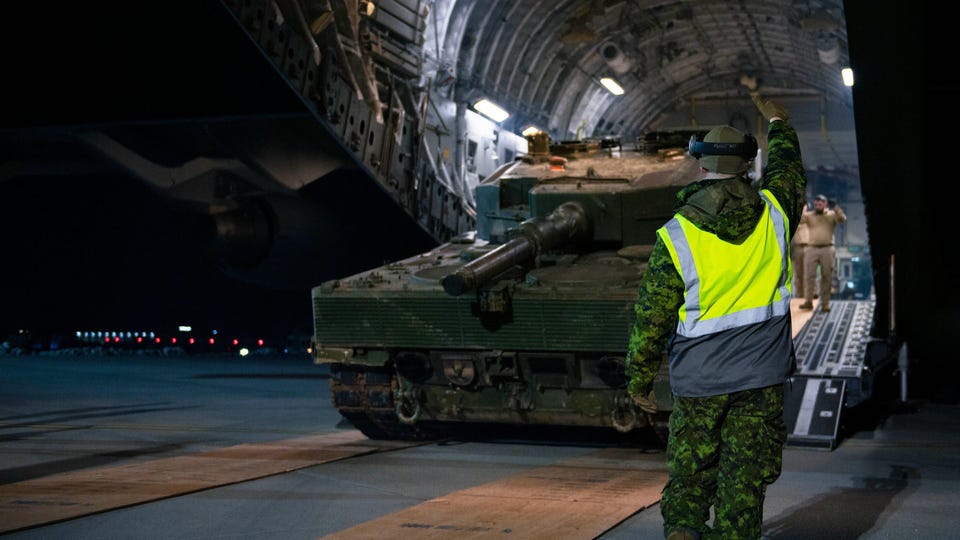The Ukrainian government’s ambition, months ago, was to get whole brigades of new tanks from its Western allies. But the political and industrial reality is that the Ukrainians will get battalions or even companies of tanks—and slowly . For context, a brigade might have a hundred tanks.
A battalion might have 30. A company—just a dozen or so. In a diplomatic chain-reaction that began in early January when Poland, the United Kingdom and the United States respectively pledged to Ukraine small batches of Leopard 2, Challenger 2 and M-1A2 tanks, no fewer than 10 NATO countries have committed to sending Western-style tanks.
Altogether, that’s 14 Challenger 2s, 32 Leopard 2A4s, 17 big-gun Leopard 2A6s and 31 M-1A2s. Oh, and at least 100 Leopard 1A5s, too—although those relatively lightweight tanks aren’t in the same class as the heavyweight Challenger 2s, Leopard 2s and M-1s. The Ukrainians would be wise not to mix and match the different tank types in the same battalions.
A battalion is the basic unit for ground combat. And battalions usually simplify their training and logistics by using the fewest possible different types of vehicles. The Ukrainian army so far is getting enough Challenger 2s for one company.
We already know the army is training its 25th and 80th Airborne Brigades on the 70-ton, 1990s-vintage British tanks with their unique, 120-millimeter rifled main guns. The size of the United Kingdom’s initial tank consignment makes some sense. A Ukrainian airborne brigade usually possesses just one company of around 10 T-80BV tanks.
The paratroopers are comfortable folding a small tank unit into their wider order of battle. That said, it’s going to take another batch of a dozen or 14 Challenger 2s to equip the tank companies in both of the brigades that already are training to operate the British tank. The Leopard 2 consignments are a bit messier for the Ukrainians.
A 40-year-old Leopard 2A4 is a different tank than a brand-new Leopard 2A6 is. For one, the 55-ton 2A4 packs a stubby, 44-caliber main gun. The 60-ton 2A6 boasts a longer, 55-caliber version of the same 120-millimeter smoothbore cannon.
A longer gun imparts more energy to its shells, resulting in more destructive power. A rational army no sooner would mix Leopard 2A4s and 2A6s in the same battalions than it would mix Leopard 2s and Challenger 2s. The problem, for the Ukrainian army, is that it’s been promised at least a battalion of Leopard 2A4s but just a company of Leopard 2A6s.
Either the Ukrainians wheedle another dozen or 14 Leopard 2A6s from Germany or Portugal in order to form a whole battalion, or they’ll need to assign the lonely company of long-gun tanks to a brigade that, like the airborne brigades, can figure out how to deploy a small number of admittedly highly-capable tanks without simply wasting them. To the Americans’ credit, the first batch of factory-fresh M-1s they’re donating to Ukraine is sufficient for a battalion. The M-1A2 is 70 tons of tungsten-reinforced steel armor with the same 44-caliber gun as the Leopard 2A4.
It might be the world’s best tank. But to equip a brigade, the United States would need to triple its M-1 pledge. The Ukrainians so far haven’t succeeded in sourcing enough of any single Western heavy tank type to arm a whole brigade.
That could change if and when the United Kingdom ponies up more Challenger 2s, the United States pledges more M-1s or some combination of European countries offers more long-warehoused Leopard 2A4s. In the meantime, the first Ukrainian brigade fully to reequip with Western tanks probably will ride in Leopard 1A5s from the mid-1980s. A trio of private arms firms—one in Belgium, two in Germany— have 237 Leopard 1A5s in their warehouses.
European governments already are buying up at least 178 of them for onward transfer to Ukraine. Don’t hold your breath. A photo that an arms-industry insider posted online on Saturday underscores just how long it takes Western countries to give away their tanks.
The photo—from Nicholas Drummond, a British consultant to German tank-maker Krauss-Maffei Wegmann—depicts a Leopard 1A5 undergoing refurbishment, apparently at the KMW factory in Munich. It turns out, KMW chairman Armin Papperger wasn’t kidding when he warned that any tank the company sends to Ukraine first “must be completely dismantled and rebuilt. ” It’s true that, even when stored in climate-controlled warehouses, tanks degrade over time.
Their steel rusts. Their rubber seals dry out. Their optics cloud.
Simply restoring an old tank to like-new condition can take months under peacetime conditions. Upgrading it with, say, new optics might add weeks to the schedule. So even the relatively simple, 40-ton Leopard 1A5s with their 105-millimeter rifled main guns at best will trickle into Ukraine.
Between 20 and 25 of the tanks should arrive by summer, another 50 or 60 by the end of the year and the rest in 2024, the office of Ukrainian defense minister Oleksiy Reznikov told Radio Free Europe. So if Kyiv still plans to equip an entire brigade with the same new tank type, it’s going to take at least a year. A sense of urgency might speed up production.
KMW could hire an additional shift and run its plant around the clock. But that urgency is a political problem, not a corporate one. If the German government truly wants KMW to hurry up, it’s within its power to make that happen.
The unfortunate reality, for Ukraine, is that it’s getting its new tanks piecemeal, and slowly. The ponderous pace of tank donations means Ukraine’s existing tank arsenal—a thousand or so Soviet-style T-64s, T-72s and T-80s— must suffice for another year . .
From: forbes
URL: https://www.forbes.com/sites/davidaxe/2023/02/19/ukraine-wanted-whole-brigades-of-western-tanks-its-getting-fractions-of-them-instead/
